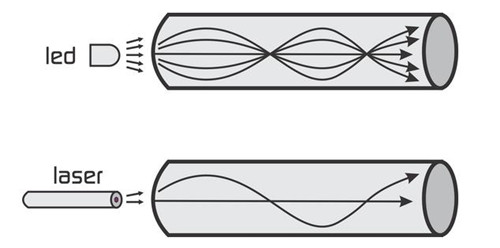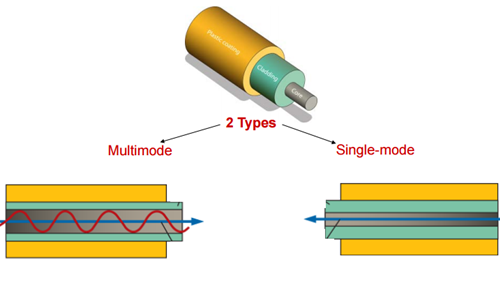We all know that transmission system is the key part of a fiber optic system. The performance of transmission system can directly affect the performance of fiber optic system. So what is the transmission system? The transmission system is a system that transmits a signal from one place to another. If you want to make sure the good performance of a fiber optic system, you should first ensure the transmission system in a good state. Next, today’s article will give you a list of basic items that may affect general transmission system performance. Only understand the following aspects can you know how to ensure the good performance of fiber optic system.
Fiber Loss Factor
Fiber loss generally has the greatest impact on overall system performance. The fiber strand manufacturer provides a loss factor in terms of dB per kilometer. A total fiber loss calculation is made based on the distance x the loss factor. Distance in this case the total length of the fiber cable, not just the map distance.
Type of Fiber
Most single-mode fibers have a loss factor of between 0.25 (1550nm) and 0.35 (1310nm) dB/km. Multimode fibers have a loss factor of about 2.5 (850nm) and 0.8 (1300nm) dB/km. The type of fiber used is very important. Multimode fibers are used with L.E.D. transmitters which generally don't have enough power to travel more than 1km. Single mode fibers are used with LASER transmitters that come in various power outputs for "long reach" or "short reach" criteria.

Transmitter
There are two basic type of transmitters used in a fiber optic systems. LASER which come in three varieties: high, medium, and low (long reach, medium reach and short reach). Overall system design will determine which type is used. L.E.D. transmitters are used with multimode fibers, however, there is a "high power" L.E.D. which can be used with Single mode fiber. Transmitters are rated in terms of light output at the connector, such as -5dB. A transmitter is typically referred to as an "emitter".
Receiver Sensitivity
The ability of a fiber optic receiver to see a light source. A receiving device needs a certain minimum amount of received light to function within specification. Receivers are rated in terms of required minimum level of received light such as -28dB. A receiver is also referred to as a "detector".
Number and Type of Splices
There are two types of splices. Mechanical, which use a set of connectors on the ends of the fibers, and fusion, which is a physical direct mating of the fiber ends. Mechanical splice loss is generally calculated in a range of 0.7 to 1.5 dB per connector. Fusion splices are calculated at between 0.1 and 0.5 dB per splice. Because of their limited loss factor, fusion splices are preferred. The following image vividly shows a good fiber connectivity and bad fiber connectivity, which may make a big difference in the insertion loss.

Margin
This is an important factor. A system can't be designed based on simply reaching a receiver with the minimum amount of required light. The light power budget margin accounts for aging of the fiber, aging of the transmitter and receiver components, addition of devices along the cable path, incidental twisting and bending of the fiber cable, additional splices to repair cable breaks, etc. Most system designers will add a loss budget margin of 3 to 10 dB.
Selecting the Right Fiber Optic Cable
Of course, only knowing this is not enough. Fiber optic cable always plays an important part in the transmitting system. As a result, the quality of the fiber optic cable is of vital value to the whole fiber link. To choose a fiber optic cable, you need to know the following:
First: what type and grade of fiber is required? The system designer will have identified the fiber that is required for the network. Find the fiber type that is needed from the Fiber Specification and Selection Guide. Use the Fiber Type code to identify the fiber. This code becomes the first two digits of the catalog part number, replacing the XX notation. There are two common types of fiber optic cables—singlemode and multimode fiber optic cables.

Then, how many fibers are required? The system designer will also have identified the number of fibers that will be in each cable. Fibers are usually cabled in groups of 6, 12, 24, 48, or 72.
Last but not least: what cable construction is needed? The cable construction that is needed is based on a variety of factors. We have a full range of products for premises, outside plant and indoor/outdoor to solve nearly every application need. Using the catalog as a guide, identify the cable type and construction that is needed. For example, Pull tab LC cable is a type of cable that uses MPO-HD to LC-HD Push Pull TAB connector.
Summary
To ensure the better performance of your fiber optic system, you are supposed to keep the above recommendations in your mind firmly. If you feel puzzled about how to ensure the better performance of your fiber optic system, you can also turn to a reliable vendor to help you out. Fiberstore as a rising telecom manufacturer, is committed to provide first-class services and high-quality products to our customers. For fiber optic cables, you can find many kinds with good quality and reasonable prices in FS.COM. A new type of fiber optic cable (Push-Pull patch cable) is also provided. Any questions, please feel free to contact us.


بخش مربوط به اینترنت ftth فوقالعاده بود! خیلیها هنوز تفاوت FTTH با سرویسهای معمولی رو نمیدونن. مقاله شما خیلی کمک کرد.
ReplyDelete